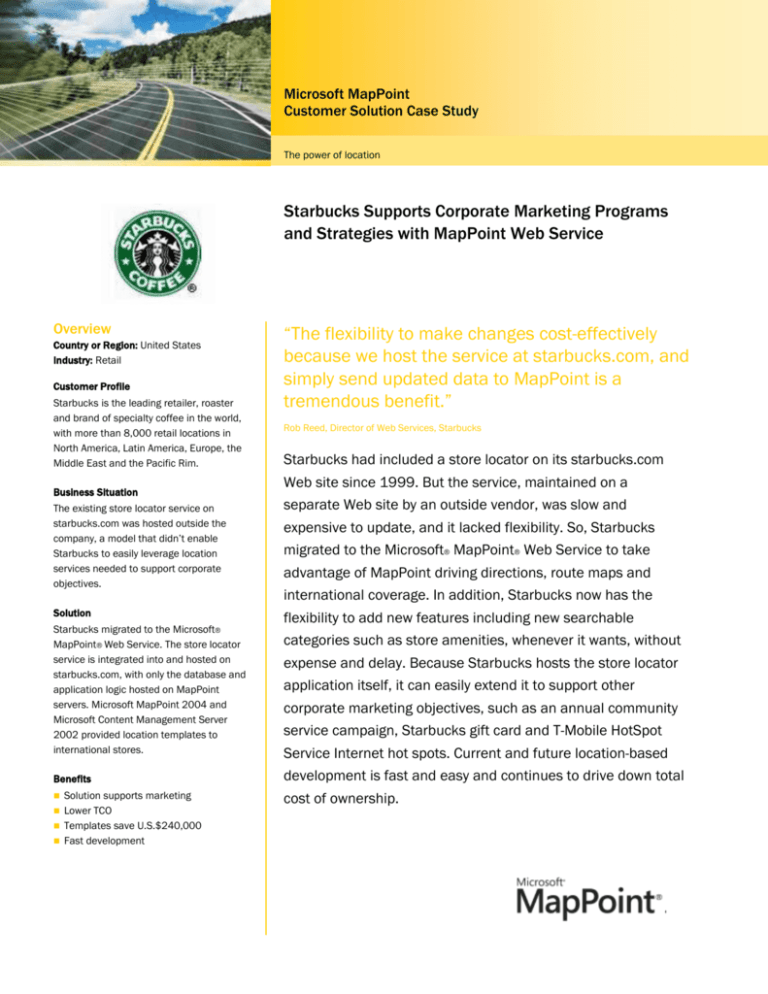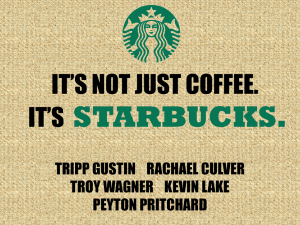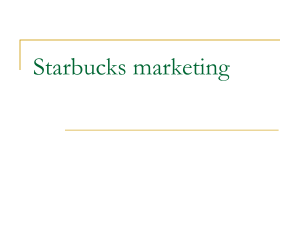
Microsoft MapPoint
Customer Solution Case Study
The power of location
Starbucks Supports Corporate Marketing Programs
and Strategies with MapPoint Web Service
Overview
Country or Region: United States
Industry: Retail
Customer Profile
Starbucks is the leading retailer, roaster
and brand of specialty coffee in the world,
with more than 8,000 retail locations in
North America, Latin America, Europe, the
Middle East and the Pacific Rim.
Business Situation
The existing store locator service on
starbucks.com was hosted outside the
company, a model that didn’t enable
Starbucks to easily leverage location
services needed to support corporate
objectives.
Solution
Starbucks migrated to the Microsoft®
MapPoint® Web Service. The store locator
service is integrated into and hosted on
starbucks.com, with only the database and
application logic hosted on MapPoint
servers. Microsoft MapPoint 2004 and
Microsoft Content Management Server
2002 provided location templates to
international stores.
Benefits
Solution supports marketing
Lower TCO
Templates save U.S.$240,000
Fast development
“The flexibility to make changes cost-effectively
because we host the service at starbucks.com, and
simply send updated data to MapPoint is a
tremendous benefit.”
Rob Reed, Director of Web Services, Starbucks
Starbucks had included a store locator on its starbucks.com
Web site since 1999. But the service, maintained on a
separate Web site by an outside vendor, was slow and
expensive to update, and it lacked flexibility. So, Starbucks
migrated to the Microsoft® MapPoint® Web Service to take
advantage of MapPoint driving directions, route maps and
international coverage. In addition, Starbucks now has the
flexibility to add new features including new searchable
categories such as store amenities, whenever it wants, without
expense and delay. Because Starbucks hosts the store locator
application itself, it can easily extend it to support other
corporate marketing objectives, such as an annual community
service campaign, Starbucks gift card and T-Mobile HotSpot
Service Internet hot spots. Current and future location-based
development is fast and easy and continues to drive down total
cost of ownership.
Situation
“MapPoint-driven location
templates are offered as
a la carte Web site
building blocks to country
market partners as we
open up new operations
in countries like the U.K.
and Greece. MapPoint
has cut our IT costs to
virtually zero compared to
an average expense of
$30,000 per country. This
year we’ll likely save
upwards of $240,000.”
Starbucks.com is the Web site of Starbucks
Coffee Company, the world’s largest retailer
and roaster of specialty coffee in the world.
Millions of customers—25 million, to be
precise—visit the company’s stores each
week. But in order to do so, many of them
first visit starbucks.com to locate the nearest
store. The store locator service, added to the
site in 1999, is one of the most popular
services on starbucks.com, and the most
popular page on the site after the home page
itself.
Using the store locator service hasn’t always
been easy for Starbucks or for its customers.
Initially, its provider managed the
starbucks.com store locator service as a
separate Web site at its own site. That meant
starbucks.com was actually operating from
two sites, a model that lacked flexibility,
according to Rob Reed, Director of Web
Services for Starbucks.
Rob Reed, Director of Web Services, Starbucks
“When we wanted to make changes to our
store locator site, it could take two or three
weeks,” Reed said. “And it was completely
out of our control. We had to hire the vendor,
at added expense, to make each change we
wanted.”
The lack of integration with its own site cost
Starbucks in several ways. When a customer
moved from starbucks.com to the store
locator site, Starbucks lost the tracking data
for that customer’s visit, as well as any
personalization data the customer may have
provided in response to targeted promotions.
When the company wanted to set up storelocator-based Web sites for other purposes,
such as promotion of its month-long “Make
Your Mark” community service campaign, it
had to redo its development effort from
scratch. Driving instructions were difficult to
provide. Nor was it easy for Starbucks to add
new categories of information—for example,
stores with wireless access or stores with
drive-through windows—or leverage its
relationship with strategic partners by, for
example, showing the location of partner
stores near Starbucks locations.
Solution
To solve these problems, Starbucks migrated
its starbucks.com store locator feature to the
Microsoft® MapPoint® Web Service, an
Extensible Markup Language (XML)-based
Microsoft .NET Web service. In contrast to the
separate, vendor-based site on which
starbucks.com had relied for store locator
services, Starbucks now provides the store
locator services to its customers directly and
those customers never have to leave the
starbucks.com site, as they did before.
Starbucks hosts starbucks.com, including the
MapPoint-based store locator service, on four
load balanced Compaq ProLiant DL 380
servers running Microsoft Windows® 2000
Advanced Server with the Microsoft .NET
Framework 1.0 and Microsoft Commerce
Server 2002. When customers hit
starbucks.com, a link on the home page
brings them to the store locator page where
they can request a proximity search for all
stores within a specific radius. Visitors can
also search for stores meeting any of nine
criteria, such as locations with wireless
access, lunch offerings or a drive-through
window. Because the MapPoint locator
service is hosted by Starbucks and is always
under its control, the company can easily
expand or modify these criteria to meet its
changing needs.
When the customer makes the request, the
MapPoint Web Service goes out over the
Internet to MapPoint servers hosted by
Microsoft, which host store data provided
previously (and updated weekly) by
Starbucks. The MapPoint servers identify
stores meeting the customer’s criteria and
return that data to starbucks.com in industrystandard Simple Object Access Protocol
(SOAP) and XML format. Starbucks.com then
“We cut our
development time and
cost by 20 percent, so
customers were able to
start benefiting quickly
from the MapPoint Web
Service. And as we
extend our store locator
with new features and
use it to support other
projects at Starbucks,
we can cut the time to
benefit for those
extensions, as well.”
The MapPoint Web Service allows starbucks.com customers to find stores meeting criteria devised
by Starbucks, including “Wireless HotSpot Stores,” “Lunch Available” and “Drive Through Window.”
Evan Klopp, Solutions Architect, Starbucks
When customers click on one of the stores identified for them by the MapPoint-based store locator,
they get full information on the store’s facilities, as well as the option to request driving instructions
and a route map.
Driving instructions and a route map are new capabilities that starbucks.com was able to
add by migrating its store locator service to the MapPoint Web Service.
renders the data in HTML and presents it as a
Web page to the customer. Because all the
rendering is done at starbucks.com, the
company can easily update the page display
to match graphics and content elsewhere on
the site.
The customer can then request and obtain
driving directions and a route map for any of
the identified stores, with the MapPoint Web
Service again working in cooperation with
MapPoint servers at Microsoft. The driving
instructions and route-map functionality were
not readily available with Starbucks’ previous
store locator service.
In addition to requesting all stores (or those
matching specific criteria) within a given
radius, visitors to the starbucks.com store
locator also can request a list of stores in a
given state. This request is fulfilled not by a
Web service call to the MapPoint servers, but
by a Microsoft SQL ServerTM 2000 call to a
copy of the store database located directly on
starbucks.com.
Benefits
Integration, Extensibility to Support Marketing
Programs and Future Flexibility
“With the MapPoint Web Service as the
engine for our store locator service, we can
easily leverage location services to support
our marketing programs—and that wasn’t the
case with our previous store locator service,”
Reed said. “The flexibility to make changes
cost-effectively because we host the service
at starbucks.com, and simply send updated
data to MapPoint is a tremendous benefit.”
For example, Starbucks plans to use the
expanded points-of-interest feature available
in MapPoint. It already takes advantage of
MapPoint-based international coverage of key
markets important to the company, such as
Asia, Europe and Latin America—coverage it
did not have with its previous vendor. Also,
Starbucks can enter into strategic
relationships with other retailers and show
their stores on the MapPoint maps as well. It
can add new products and services and
enable customers to search for stores that
feature these services. And it can do all this
without waiting weeks for an outside vendor
to implement the changes.
With the MapPoint Web Service, Starbucks
gains the flexibility to use its store locator
service to support other programs at the
company. For example, Starbucks is able to
use the existing service to support a separate
Web site for its “Make Your Mark” community
service campaign. In the past, the company
would have had to develop an entirely new
store locator service to support the program.
“The beauty of the MapPoint Web Service is
that it puts the store locator function entirely
under our control,” Reed said. “It’s easy to
expand its use to accommodate other
purposes with very little development effort.”
What does an innovative company like
Starbucks have in mind for future uses of
MapPoint Web Service? Reed explains:
“We are getting customer requests for new
kinds of location-oriented searches,” said
Reed. “For example, trip-planning requests
such as where Starbucks stores are located
off a major freeway or store-hours searches
to accommodate early morning and late night
customers. We’ll be looking at potentially
adding these and other features in the future
as MapPoint makes offering new search
options quite painless.”
MapPoint Web Service also supports one of
Starbucks’ underlying corporate strategies.
“MapPoint Web Service has played an
important role in our overall strategy of
encouraging patrons to linger longer at our
stores,” said Reed. “If they can more easily
find a particular store and amenity, it not only
affects how long they stay, it’s also incredibly
helpful in building the value of our worldwide
brand.”
The overall business value that MapPoint
Web Service and Microsoft MapPoint 2004
have delivered to Starbucks is summed up by
director of Web services, Rob Reed:
“MapPoint is playing a vital support role at
Starbucks. It dovetails extremely well with our
various existing corporate marketing
programs and gives us a hint at directions we
might like to go in the future.”
Better Customer Service Contributes to Lower
TCO; Services Searches Soar
“The store locator is one of the most popular
features on starbucks.com,” Reed said. “So
we had to get it right in order to provide
superb service to our customers. With the
MapPoint Web Service, we do. The service
scales to meet our needs without any
problem.
“In addition to delivering fast, flawless
performance, the MapPoint Web Service
enables starbucks.com to deliver customer
service so good, it actually cuts costs to the
company. In the past, requests for driving
directions were one of the top three reasons
that customers called the company’s
customer service phone line. With driving
directions and route maps available through
MapPoint, those calls have virtually dropped
off our radar screen,” Reed said.
Over the last six months, the use of the
Starbucks.com Web site store and services
locator has soared. What the company found
was that Starbucks customers returned to its
Web site repeatedly to discover what was
new at stores near where they lived or
travelled. In fact, the more familiar a market
was with the Starbucks brand, the more
frequently they visited its Web site to check
out what was new.
“One of the Web site surprises was the jump
in locator searches for store services such as
Internet access and grab and go
sandwiches,” said Reed. “It’s climbed 20-30
percent in the last six months. The ability to
deliver both store and services location
information to Web visitors is very important
to us.”
“One of the added benefits of having store
locator capabilities on our Web site is helping
customers find alternative Starbucks
locations,” said Reed. “New stores opened
with retail partners like Barnes & Noble and
Albertsons offer great options for patrons in
neighborhoods and business areas alike.”
Rapid Deployment of Location-Based
Web Templates Will Save Starbucks an
Estimated $240,000 This Year in
International IT Costs
Another key benefit of using Microsoft
MapPoint Web Service, Microsoft Content
Management Server 2002 and associated
development tools is the ability to create
store and service location templates that can
be used by new Starbucks stores to build
their Web sites. This rapid solution
development is particularly beneficial
internationally.
“MapPoint-driven location templates are
offered as a la carte Web site building blocks
to country market partners as we open up
new operations in countries like the U.K. and
Greece,” said Reed. “MapPoint has cut our IT
costs to virtually zero compared to an
average expense of $30,000 per country.
This year we’ll likely save upwards of
$240,000.”
Fast, Easy Development Means Short
Wait to See Benefits
Migrating the starbucks.com store locator
service to the MapPoint Web Service was a
relatively straightforward process completed
in a few weeks, according to Evan Klopp,
Solutions Architect at Starbucks. First,
existing store location data was geo-coded for
the MapPoint servers and uploaded to them.
Then, MapPoint code was integrated into the
existing code base of starbucks.com, using
the MapPoint Software Development Kit
(SDK), the Microsoft Visual Studio® .NET
2002 and Visual C#® development tool.
Microsoft Consulting Services provided an
assist to ensure that starbucks.com got its
new store locator up and running quickly.
“We had experience with [Microsoft] .NETconnected technology, so there wasn’t much
of a learning curve,” Klopp said. “The
integration between Visual Studio .NET and
the Web service made calling the service
easy. With Microsoft APIs [application
programming interfaces] and tools, such as
[Microsoft] IntelliSense®, we cut our
development time and cost by 20 percent, so
customers were able to start benefiting
quickly from the MapPoint Web Service. And
as we extend our store locator with new
features and use it to support other projects
at Starbucks, we can cut the time to benefit
for those extensions, as well.”
For More Information
Microsoft MapPoint
For more information about Microsoft
products and services, call the Microsoft
Sales Information Center at (800) 4269400. In Canada, call the Microsoft
Canada Information Centre at (877) 5682495. Customers who are deaf or hard-ofhearing can reach Microsoft text telephone
(TTY/TDD) services at (800) 892-5234 in
the United States or (905) 568-9641 in
Canada. Outside the 50 United States and
Canada, please contact your local
Microsoft subsidiary. To access information
using the World Wide Web, go to:
www.microsoft.com
Microsoft MapPoint is the preferred choice
for platforms, applications, and services that
deliver precise mapping, map-related
content, and tools. Microsoft MapPoint helps
businesses increase their efficiency and build
strategic value with solutions that make it
easy to locate customers and competitors,
analyze trends, and evaluate risks and
opportunities. For developers, Microsoft
MapPoint supports a variety of programming
environments, includes options for Webbased services, and offers tools that speed
the development of location-based
applications. In addition, Microsoft MapPoint
delivers solutions that integrate location data
into business applications, ease the task of
address searches, and include options for
remote devices.
For more information about Starbucks
products and
services, and
products
call services,
or visit the
visit
Web
thesite
Web
at:site at:
www.starbucks.com
For more information about products and
services, call or visit the Web site at:
For more information about Microsoft
MapPoint, go to:
www.microsoft.com/mappoint
Or send email to:
maplic@microsoft.com
Software and Services
Microsoft MapPoint Web Service
Microsoft MapPoint 2004
Microsoft Windows Server SystemTM
– Windows 2000 Advanced Server
– Microsoft .NET Framework 1.0
– Microsoft Commerce Server 2002
Microsoft Visual Studio .NET 2002
Microsoft Visual C# .NET
© 2005
2003 Microsoft Corporation. All rights reserved. This case
study is for informational purposes only. MICROSOFT MAKES NO
WARRANTIES, EXPRESS OR IMPLIED, IN THIS SUMMARY.
Microsoft, IntelliSense,
Example: Active
MapPoint,
Directory,
Visual
Windows,
C#, Visual
the Windows
Studio,
logo, Windows
Windows,
and Windows
Server, and
Server
Windows
System
Server
are either
System
registered
are either
registered trademarks
trademarks
or trademarks
or trademarks
of Microsoft
ofCorporation
Microsoft Corporation
in the
in
the United
United
States
States
and/or
and/or
other
other
countries.
countries.
The The
names
names
of actual
of actual
companies and products mentioned herein may be the
trademarks of their respective owners.
Document published March
July, 2004
2005
Microsoft Consulting Services
Hardware
Compaq ProLiant DL 380 servers








